I’ve spent two amazing decades working in beauty design. To get there, I paid my way through art school with a part-time job at my local supermarket, spending countless hours stacking laundry product shelves. Until very recently, I could never, ever have envisaged the emergence of a new product category that blended the two!
Household brands are traditionally designed to convey power, speed, and performance. To stand out and literally shout on the shelf to grab customer attention. Think big bold typography in garish colours with swooshes, literal pictures of washing machines, and giant science motifs. The idea that the products could ever be put proudly out on display on your granite countertop and not hidden away in the laundry room or kitchen cupboard was pretty much unthinkable.

Things started to change with the arrival of household brand Method in the early 2000s, with its nonconformist design, toxic-free formulas, and innovative structuring. But in large part until very recently, household was household and beauty was beauty, the only overlaps being scented candles, room sprays, and the odd hand wash. But much like food and health have blurred into wellness, today there is an entirely new, exciting category emerging: Beauty Household.
Beauty Household—beautifully designed and smelling clothes, hand and surface cleansers and conditioners, space fresheners and more—has a considered aesthetic, taking cues from the world of beauty brands. And why not? If fragrance, moisturisers, and bath oil bottles can be used to actively adorn my dressing table or bathroom side, why shouldn’t well-designed home products?
Aesop is probably so far the most established brand in this new space. Its distinctive, gender-neutral design identity translates beautifully to the home. Interior magazines regularly feature its hand wash displayed proudly in immaculate kitchens and bathrooms, alongside its iconic Post-Poo Drops, the most elegant solution possible to toilet smells.

As to why this new category has emerged, it’s largely down to two wider consumer trends: the rise of natural/organic and the broadening and meaning of the fragrance category. And indeed in the way those two trends intertwine with the home in its entirety being seen as the ultimate location for self-care.
With the former, the thinking goes: if I care deeply about what I put in and onto my face, body, and hair, why on earth would I not care about what products go onto to my clothes and on the kitchen surfaces and crockery that my food comes into contact with? The property of non-toxic cleansing and care is one that can easily be stretched.
With the latter, there is now a far greater focus on fragrance as an expression of personal identity and a greater understanding of how it can impact mood in every environment. And it has been niche and artisanal fragrances, many with a natural bent, that have led the way in this. Natural fragrance ingredients such as essential oils and aromatic herbs often have cleansing and deodorising properties that enable them to be used fluidly in any number of formats.
Globally, you see fragrance and beauty brands moving into home care, and home care brands stretching into fragrance and beauty to create something new. And the results are simply beautiful.
Contemporary clean
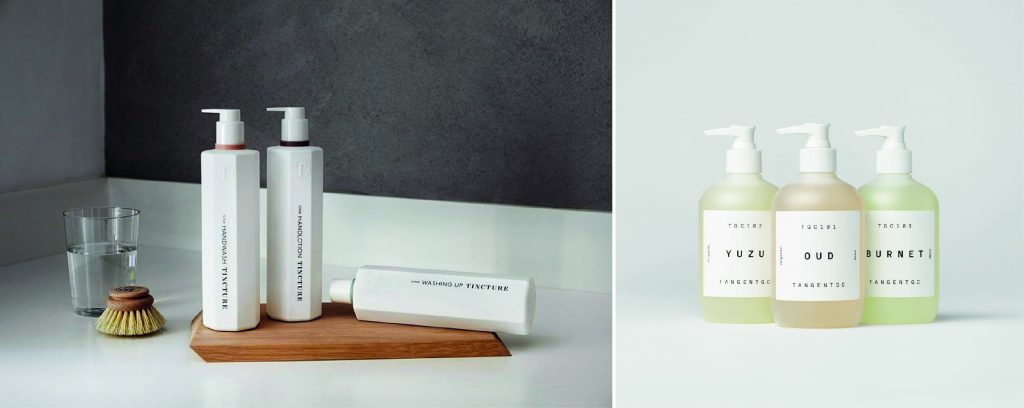
With its striking refined, white octagonal pack structure (that its brand anatomy is structured on) Tincture is a 100% natural household cleaning and freshening range using essential oils and active botanical ingredients.
TANGENT GC’s products are billed as organic care for the precious and started as an eco-friendly garment and shoe care brand, and would not look out of place in the most rarefied Brooklyn barbershop. Most recently, it’s extended out into skin care, with single-note multipurpose Castile soaps like Yuzu and Oud reflecting the niche fragrance-naming trend.
Tom Dixon website and L’EAUNDRY website
Almost indistinguishable from contemporary fragrance bottles is the Berlin-based L’EAUNDRY range of fabric washes, made in collaboration with top perfumers “to enhance everyday life, from our skin to our clothes to our home.” They have even taken the now classic route of beauty Limited Edition sets with a collaboration with floral stylists Mary Lennox, that combines miniature bottles with limited-edition postcards and packaging. Tom Dixon, the legendary interior and product designer, has extended his ultra-modern luxe aesthetic of copper, white, and black into a range of dish- and hand-washing and care products.
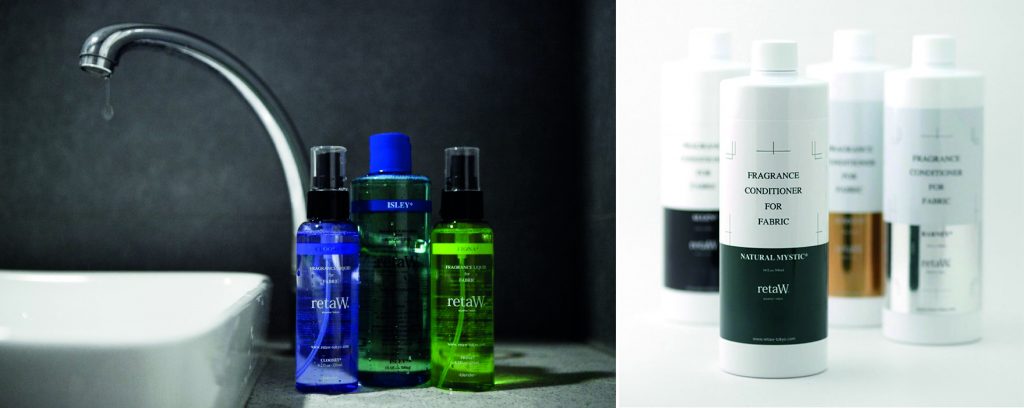
In Japan, leading taste-maker Hiroshi Fujiwara created retaW (the word, water, reversed) dedicated to creating a “full, holistic lifestyle wrapped in scent,” with products organised according to a fragrance inspired by a musician or record. Products have contemporary structures with a colour palette of khaki, white, blue, green, and metallic silver and copper accents, aimed at fragrancing every part of your environment: classic personal care, candles, home and car air freshening tags, fabric liquids, room sprays, and more.

Other household beauty brands taking their cues from the contemporary monochrome beauty aesthetic include Ashley & Co (offering everything from lip balm to hair care via fabric cleansing) and FREY’s men’s grooming-styled fabric care range exhorting you to: “Smell good. Live remarkably.”
Heritage hygiene
But just as beauty is not all about ultra-modern design, established beauty cues that convey tradition and heritage are well represented in Household Beauty too.
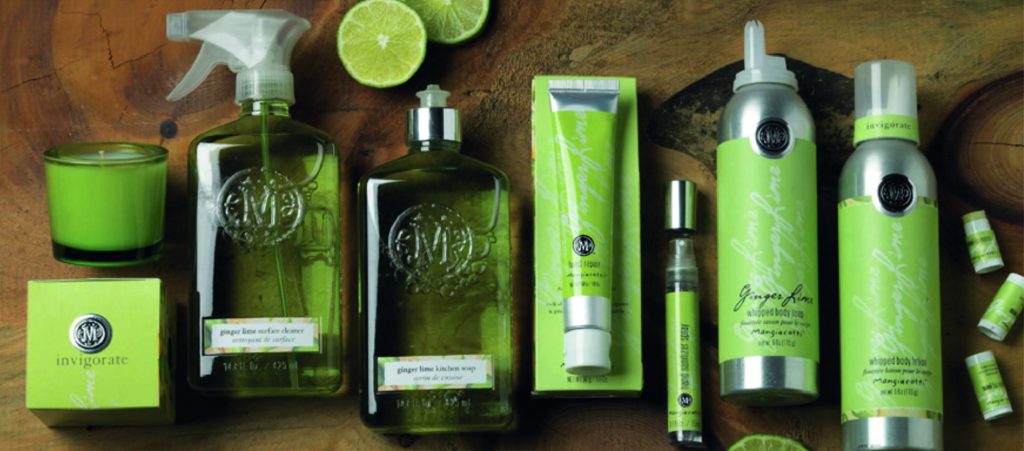
Mangiacotti was established by a former advertising art director and designer who worked off the simple premise that an everyday item can be transformed into the perfect gift if it looks and is fragranced exceptionally well. Her earth-friendly personal care, homekeeping, and home fragrance ranges draw on its natural fruit and botanical ingredients, with logo type, illustrations, and debossed packs, drawing heavily on the French savonnerie tradition.
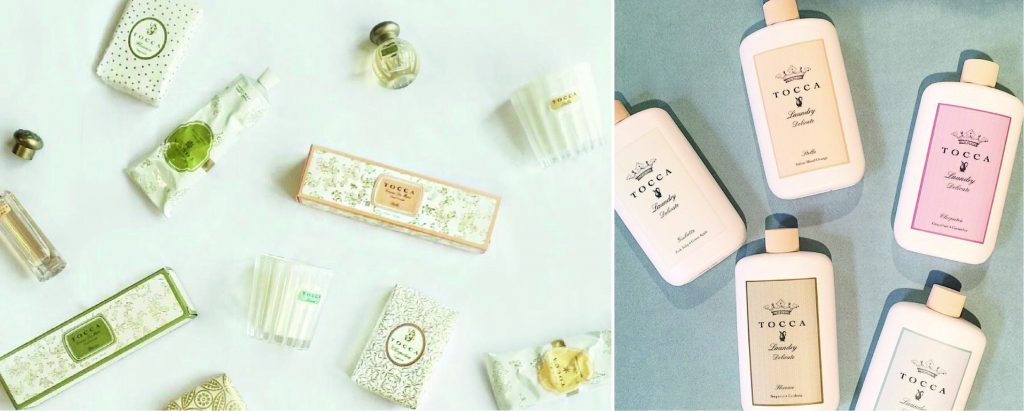
Tocca, meaning “touch” in Italian, is a well-known niche, luxury fashion and fragrance house based in New York City. With a founding mission to make travel-inspired, masterfully crafted, luxury goods accessible to all, it was a logical step to take the brand’s intricate motifs and typography into a laundry care range, with evocative variant names such as Cleopatra, Stella, Florence, Giulietta, and Bianca.
Japanese fabric care brand, Fullery Botanical, harks back to the traditional apothecary, creating a brand story across its digital activation and pack that uses illustration, dark woods and colours, and naturalistic illustration to convey heritage and ingredient provenance.
Australian brand Murchison-Hume, whose home, hand, and candle range is all about “sparking joy each time you use it,” also uses traditional illustrated motifs and serif font in its pack designs, married to more contemporary structures.
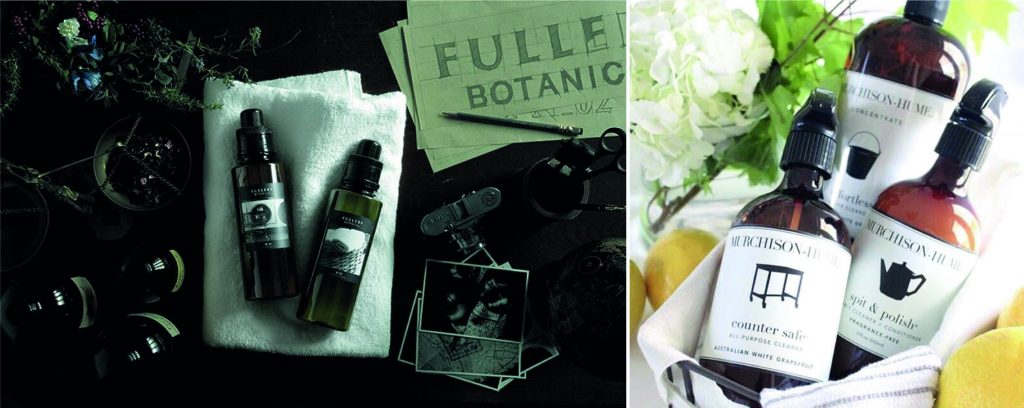
What’s clear is that the thought and care that’s gone into these products, their brand architecture, visuals, and storytelling, is every bit as exacting as that gone into traditional beauty brands. In some cases, far more so. And now that Household Beauty is firmly here, it seems almost ridiculous that it didn’t exist before. Why would you go to all the trouble of washing and moisturising yourself with beautifully fragranced natural products and then put on clothes immersed in synthetic, nose-jangling strong scents. Why wouldn’t you want them to exactly match your perfume or at least harmonise with it?
Beauty Household offers all sorts of opportunities for beauty and household brands to play in a new, compelling lifestyle space that reflects consumers’ growing desire for cocooning and personalisation. And IKEA’s collaboration with Byredo is a sign of just how exciting and playful it might be. Remarkable.